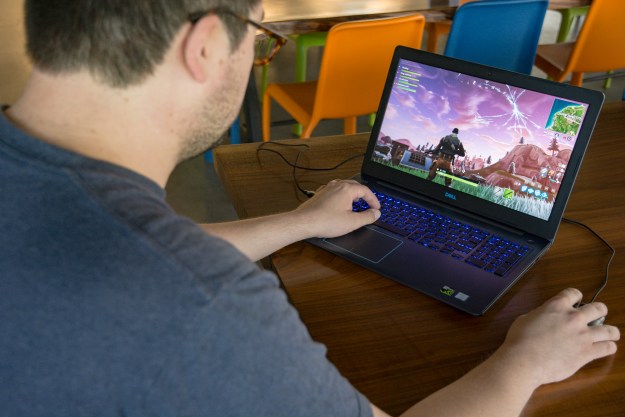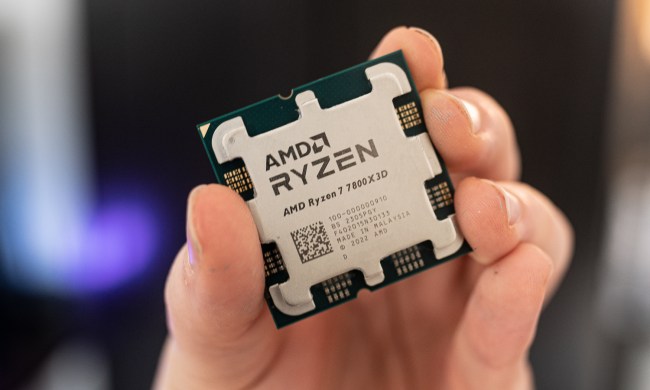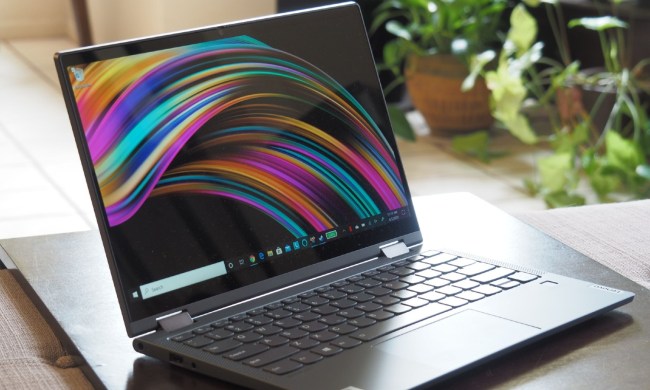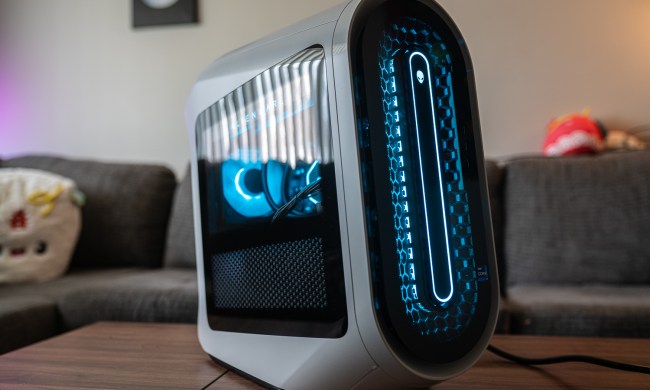
“Dell has figured out what gamers want -- and what they can live without.”
- Decent build quality
- Great value
- Fairly thin and light
- Good performance
- Improved battery life
- Bland design
- Slow storage options
- Display’s colors are dull, inaccurate
No one likes to make compromises, but with gaming laptops, it’s inevitable. When you head into the sub-$1,000 range, those compromises can become even more significant, often denying a machine our recommendation.
At the same time, the Dell Inspiron 15 5000 series has often been the exception to this rule, and it’s often earned honors as our favorite budget gaming laptop. Now, Dell has re-launched the product line, changing the name to Dell G series – which includes the Dell G3, G5, and G7. The notebooks start as low as $750 (currently on sale for $680). Our $850 configuration of the Dell G3 came packing an Nvidia GTX 1050 Ti and a 128GB SSD.
Cutting corners can be a risky business, but our time with the G3 has shown that Dell knows what features matter to gamers on a budget.
Oh, this is a gaming laptop?
Dell is known for its cutting-edge design in laptops like the XPS 13 and 15, and for shrinking chassis and bezels like nobody’s business. You might have laid eyes on the Dell G7, which comes in a pristine “Alpine” White colorway. Unfortunately, not much of that style has found its way to the less expensive G3. Between the lid, Dell logo, backlit keys, and keyboard deck, there’s four different shades of blue — and it’s a few too many. It also has thick bezels around the display, reinforcing the outdated aesthetics of the laptop.
Still, it’s nondescript at worst. It doesn’t make a fool of itself with cheap chrome and red color swatches, a trap a lot of budget gaming laptops fall for. HP’s Omen 15 or Predator Helios 500 are examples of a notebook that’s styled more like a conventional “gaming laptop” with jet engine exhausts and flashing lights.
What it lacks in distinctive style the G3 makes up for in build quality. The plastic chassis is reinforced in all the right places. Even the hinge felt sturdy, making it easy to open and close with one finger.
The 15-inch version we tested was reasonably svelte considering the price and the hardware inside. At 5.6 pounds and 0.89 inches thick, it’s not nearly as portable as the Dell XPS 15 or Razer Blade, but it cuts the bulk from the previous iteration. It’s mobile enough to throw in your backpack, but not enough so that you won’t notice the extra weight.
No frills necessary
The keyboard on Dell’s budget gaming laptops have always been good, and once again, this is a keyboard we enjoyed.
The display isn’t worst-in-class, but it’s disappointing by modern standards.
It’s no gaming keyboard, though it has some of the clicky, tactile feel that gamers love. The keys don’t feel loose and the bottoming action isn’t sloppy or soft. The layout is good, though we would have preferred to remove the numpad and enlarge the keys. While we aren’t the biggest fan of the color of the backlighting, it’s bright and evenly lit. The Omen 15 has a more gamer-oriented keyboard with its highlighted WASD and 26-key rollover with anti-ghosting, but the overall typing feel is similar. Neither notebook offers the kind of mechanical keyboard that will please hardcore gamers.
The touchpad doesn’t fare as well. It’s not glass, so tracking doesn’t feel accurate, which you’ll notice most in detailed work like selecting text or carefully moving windows. It supports Windows Precision drivers for fancy multi-touch gestures, but that only highlights the sub-par touchpad surface. Dell has removed the physical buttons this time around, which we like, though the click is loud and overly stiff. It’s also wobbly, resulting in frequent mis-clicks. Gamers won’t be caught dead using the touchpad while gaming anyway, though, so saving a few bucks here isn’t the worst idea.

The ports favor those gamers need like ethernet, HDMI, and plenty of USB for peripherals. Dell even threw in a full-sized SD card slot for good measure. What’s missing here is Thunderbolt 3 (which the Omen 15 offers), taking external GPUs off the table. Even its predecessor featured at least a USB-C port, but here you’re stuck with USB-A accessories.
The display that’s just barely good enough
Budget gaming laptops are notorious for bad displays. Unfortunately, Dell continues the trend here. The display isn’t worst-in-class, but it’s disappointing by modern standards. The most egregious problem is in color, where it shows 62 percent of the sRGB color space, and only 46 of Adobe RGB. The result is a rather dull screen that lacks saturation, and it shouldn’t be used for something like photography or graphic design. It also stands alone among our comparison machines in offering such poor colors, except for Dell’s previous offering in this space, the Inspiron 15 7677 Gaming notebook.
In games, the display’s poor color is noticeable, but not distracting. A game like Battlefield 1 hinges a lot on the visual quality of its environments — and when you crank up the graphics settings, it really can be beautiful. On the G3, the display’s dullness does impact the experience, making the grim game world feel flatter than it would on a better screen. It’s certainly not enough to ruin the gaming experience on the G3, but you must understand that an affordable gaming laptop forces a compromise in image quality not found on most models sold above $1,000.
Fortunately, it’s not all bad news. The 1080p screen is bright enough, maxing out at 251 nits, and contrast is better than some expensive gaming laptops like the Alienware 17 or Digital Storm Equinox. The screen also boasts good viewing angles. We can charitably describe it as functional.

The internal speakers are another aspect of the laptop that will go underused by gamers who’ll prefer to use headphones or external speakers. What’s here isn’t terrible, but it’s not great, either.
Excellent performance, minus the storage
The G3 features the Core i5-8300H CPU, a 45-watt Intel chip that’s commonly found in budget gaming laptops like this one. It’s not the most efficient processor in the world, but it’s a huge improvement over the 7th-gen chip used in the G3’s predecessor. With a greatly increased multi-core score in our Geekbench tests, the G3 can better handle heavily multi-thread software, including games that are programmed with quad-core chips in mind.
The strength of the processor is revealing in real-world usage. We encoded a 4K video in Handbrake on the Dell G3 in just three minutes and thirty seconds. That’s only a handful of seconds behind the Core i7-8750H in the Razer Blade or Digital Storm Equinox, while also a whole minute and half faster than U-series in more conventional ultrabooks like the Razer Blade Stealth. Only some recent notebooks like the XPS 15 and the ThinkPad X1 Extreme are significantly faster.
Our configuration came with 8GB of RAM, which was plenty of memory to handle the other components included. It is removable, but with one only slot, your future upgrade options are more limited. An additional slot is featured in other configurations, but it’ll bump up your price a bit.
All the compromises made in design, storage, and display have helped Dell to keep the price low — and performance high.
As for storage, Dell offers a wide variety of options. Starting at rock bottom you can buy the $680 model with only a spacious but slow “hybrid” disk drive. We didn’t test it out, but don’t expect it to be as fast as a standard solid state drive. Fortunately, our unit came with a 128GB SK Hynix SATA SSD, in addition to the 1TB old-school HDD. The SSD had an average read speed of 500 megabytes per second and a write speed of 209 MB/s.
It’s not a lot of space, nor is it fast as the PCIe drives you’ll find in more expensive laptops, but this is where the rubber meets the road with budget configurations. Both drives are accessible and removable, should you ever want to swap them out in the future.
The GTX 1050 Ti is a performer
You might be wondering if you can enjoy play games on an $800 laptop. And we don’t mean scoot by playing Rocket League on Medium settings. We mean really game. Thankfully, all the compromises made in design, storage, and display have helped Dell to keep the price low — and performance high.
At the center of that performance is the Nvidia GTX GeForce 1050 Ti, which is solid choice for a budget gaming laptop like this one. It can be configured with either the Nvidia GTX GeForce 1050 or 1060 as well, but the 1050 Ti handles both games and benchmarks well. In 3DMark Fire Strike, the Dell G3’s 1050 Ti landed right between the 1050 and the 1060. But more importantly, games on the Dell G3 feel really snappy.
We struggled to get playable framerates in 4K with settings not lowered to the bottom, but if you stick with 1080p, you’ll be quite happy with the results. In Battlefield 1 with settings maxed, the G3 cranked out 60 frames per second — and the same goes with Fortnite. We were delighted to see how responsive gameplay felt in games like these where response time is critical.

The only real hurdle was Deus Ex: Mankind Divided, an infamously challenging game. At Ultra, the G3 struggled to rise passed 25 FPS, and even with the settings lowered to High, it managed a barely-playable 34 FPS. In demanding games like this, you’ll want to move up to the GTX 1060 for smoother gameplay.
Better battery life, but still not great
You can’t expect great battery life out of a gaming laptop. Even high-end models like the Alienware 17 R5 max out below four hours of juice. The Dell G3, with its 56 watt-hour battery, performed honorably for what it is and makes an improvement on the previous iteration.
As is common, the G3 did best in our video battery test, lasting for five hours and 43 minutes with a looping 1080p clip with the screen measured at 100 lux. For our iMacro web browsing, the G3 trucked on for five hours and 18 minutes, which again, isn’t all that shabby compared to average gaming laptops.
While that’ll dip significantly while playing games, it’s nice to know you can take it away from the wall for more than few hours at a time. You’ll have to spring for something like a Razer Blade if you need a gaming laptop with close to all-day battery life.
Our Take
The Dell G3 Gaming Laptop isn’t perfect, but it’s among the best of its breed. The compromises Dell makes to keep performance high and price low don’t sacrifice the usability of the laptop in the ways that matter. If there is one area where the compromise feels overreaching, it’s the display. We’d like to see another budget gaming laptop come along and up the standard, but so far, the G3 is your best option at this price point.
Any alternatives?
You don’t have a lot of options for gaming laptops at this price, especially not ones that compete directly with the price of the Dell G3. The HP Omen 15t Gaming comes close at $849 on sale, though that’s without an SSD, and it’s far uglier. The same goes with the Asus TUF Gaming FX504.
Instead, take a good, hard look at the different configurations of the Dell G3. Between the G3, G5, and G7, there are a nearly endless variety of options of GPUs and storage options. Even the options just over $1,000 provide a strong bang-for-your-buck value.
How long will it last?
The Dell G3 comes with a standard one-year warranty, which isn’t great — however, it’s what we’ve come to expect from large manufacturers (that aren’t Apple). While its components are all up-to-date, the missing USB-C port makes it a bit less futureproof. The replaceable memory and storage do ensure that you can upgrade in the future when you’re ready.
Should you buy it?
Yes. For gaming on the go at under $1,000, the Dell G3 is your best option.






